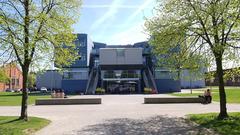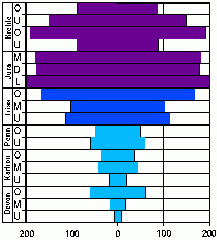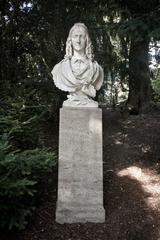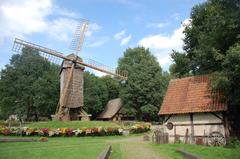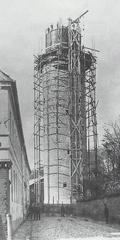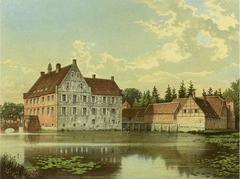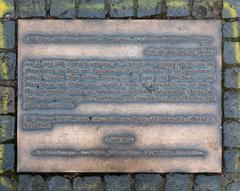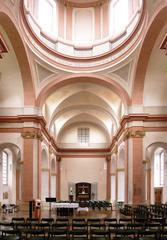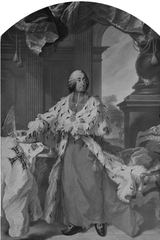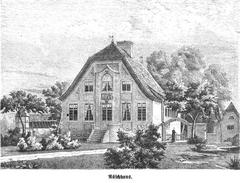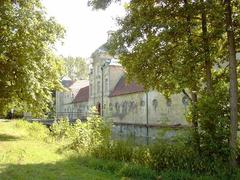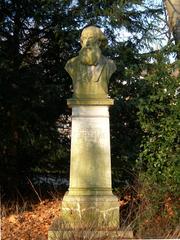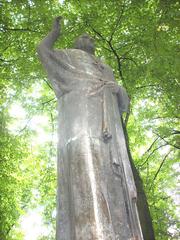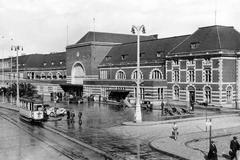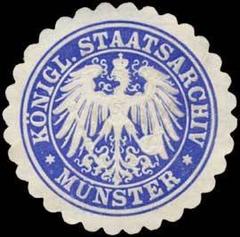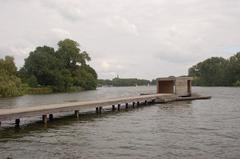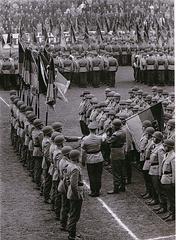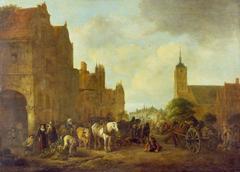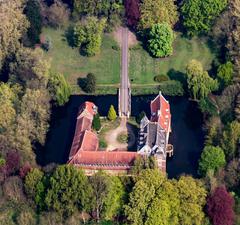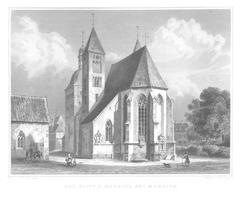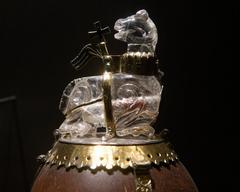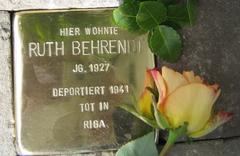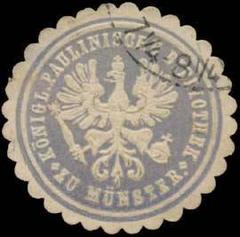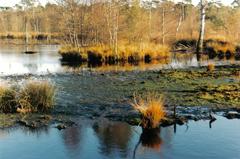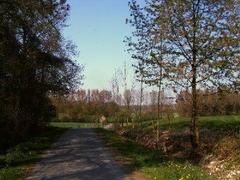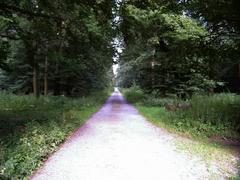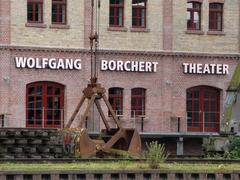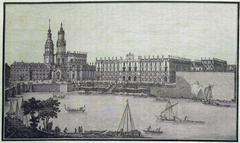
Domplatz Münster: Comprehensive Visiting Hours, Tickets, and Historical Sites Guide
Date: 04/07/2025
Introduction
Domplatz Münster, the historic Cathedral Square at the heart of Münster, Germany, is a living testament to centuries of religious, architectural, and civic heritage. As the city’s geographical and spiritual center, Domplatz seamlessly blends medieval origins, Gothic marvels, and a dynamic urban scene. From the awe-inspiring St. Paul’s Cathedral (St. Paulus Dom) with its famous astronomical clock, to vibrant weekly markets and major festivals, this square invites visitors to immerse themselves in Münster’s rich history and contemporary culture (Audiala.com, FromPlaceToPlace.travel).
Whether you are a history enthusiast, architecture lover, or a traveler seeking authentic experiences, this detailed guide provides everything you need to know: from visiting hours and ticketing, to accessibility, must-see landmarks, and insider travel tips.
Table of Contents
- Historical Overview
- Visiting Domplatz Münster: Practical Information
- Architectural Significance and Major Landmarks
- Weekly Markets, Events, and Civic Life
- Visitor Facilities, Accessibility, and Travel Tips
- Frequently Asked Questions (FAQ)
- Conclusion and Call to Action
- References
Historical Overview
Early Origins and Medieval Foundations
Domplatz’s roots reach back to the late 8th and early 9th centuries, when Charlemagne established Münster as a key religious center in Saxony. The missionary Liudger, appointed as the city’s first bishop, founded a wooden church on this site in 805 AD, laying the cornerstone for Münster’s spiritual legacy (Audiala.com). Over the next centuries, the site transformed into a fortified ecclesiastical enclave called the Domburg, with a Romanesque basilica replacing the original wooden structure by the 11th century.
Architectural Evolution: Romanesque to Gothic
The current St. Paul’s Cathedral, begun in 1225 and consecrated in 1264, showcases an impressive transition from Romanesque to Gothic architecture. The structure’s robust westwork and soaring Gothic nave reflect the era’s innovative spirit. Later additions—including the Renaissance astronomical clock in the 16th century and Baroque interior embellishments—mirror the cathedral’s evolving artistic and cultural significance (WhichMuseum.com, Wikipedia).
The 13th-century Immunitätsmauer (immunity wall) once marked the boundaries of the Domimmunität, a semi-autonomous ecclesiastical district governed by the cathedral chapter (Stadt-Muenster.de). Within, canons lived in grand curia houses, forming a self-contained community.
Religious and Cultural Significance
For centuries, Domplatz has been the spiritual heart of Münster, hosting episcopal consecrations, processions, and religious festivals. The cathedral’s astronomical clock, built in the 16th century, remains a highlight, drawing crowds for its daily noon apostle procession (Wikipedia).
The square also witnessed pivotal historic moments, such as the Anabaptist rule (1534–35) and the subsequent Counter-Reformation, which shaped the city’s religious and civic identity.
Modern Transformation and Preservation
After the secularization of the bishopric in 1802 and incorporation into Prussia, many ecclesiastical buildings were repurposed for civic use. World War II inflicted heavy damage, but postwar reconstruction restored both the cathedral and the square, blending historical elements with contemporary needs (Audiala.com). Ongoing archaeological excavations have unveiled medieval foundations and artifacts, enriching our understanding and guiding preservation efforts (Stadt-Muenster.de).
Visiting Domplatz Münster: Practical Information
Opening Hours
- Domplatz Square: Open to the public 24/7.
- St. Paul’s Cathedral: Generally open daily 9:00 AM – 6:00 PM. Sunday opening may begin at 1:00 PM. Hours may vary for holidays or special events (Paulusdom.de).
Tickets
- Domplatz: Free entry.
- St. Paul’s Cathedral: Free entry for self-guided visits. Donations are encouraged.
- Guided Tours: Available in multiple languages; tickets can be booked online or at the Münster Tourist Information Centre. Fees apply depending on tour type and group size.
Accessibility
- Wheelchair Access: Both Domplatz and cathedral entrances are accessible with ramps and flat surfaces. Barrier-free restrooms and inclusive guided tours are available.
- Assistance: Support for visitors with disabilities is available upon request.
Getting There
- Public Transport: Multiple bus lines stop at or near Domplatz. Münster Hauptbahnhof (main train station) is a 15-minute walk away.
- By Bicycle: Münster is Germany’s “bicycle capital,” with extensive cycling infrastructure and nearby bike parking.
- By Car: Parking is available in nearby garages; spaces may be limited during events (PenguinAndPia.com).
Architectural Significance and Major Landmarks
St. Paul’s Cathedral (St. Paulus Dom)
The cathedral dominates Domplatz with a harmonious blend of Romanesque and Gothic styles. Inside, visitors are greeted by an expansive nave, medieval sculptures, intricate stained glass, and the renowned astronomical clock, famous for its noon procession (FromPlaceToPlace.travel, ScriptureSavvy.com). The treasury houses invaluable medieval artifacts.
Prinzipalmarkt
This historic, gabled street just steps from Domplatz is Münster’s commercial heart. Its arcaded buildings, reconstructed after WWII, house boutiques, cafés, and markets, connecting Domplatz to other city highlights (MilitaryInGermany.com).
Historical City Hall (Rathaus)
Famed for the Peace of Westphalia treaties (1648), the City Hall’s Gothic façade and the Hall of Peace are open for guided tours (ScriptureSavvy.com).
St. Lambertus Church
A short walk away, this Gothic landmark is renowned for its tower with iron cages—reminders of Münster’s Anabaptist past (MilitaryInGermany.com).
The Zwinger
Once part of the city’s fortifications, the Zwinger now serves as a WWII memorial and contemporary art venue (Trek.zone).
Weekly Markets, Events, and Civic Life
Weekly Markets
Domplatz hosts Münster’s lively farmers’ markets every Wednesday and Saturday morning, featuring regional produce, flowers, crafts, and local specialties (The Crazy Tourist). On Fridays, the Biomarket emphasizes sustainable, locally grown foods (Wikipedia).
Cultural Events
Major festivals, such as Stadtfest Münster (August 15–17, 2025), feature concerts, performances, and open-air celebrations (MS Aktuell). The square also hosts seasonal events like the Christmas market and the Schauraum festival (Muensterland.com).
Civic and Religious Center
Domplatz is a daily meeting place for locals, students, and tourists. It is also a focal point for religious ceremonies and processions, with barrier-free access ensuring inclusivity for all (Explorial).
Urban Development
Recent initiatives like the “Domplatz-Dialog” encourage public participation in shaping the square’s future, reinforcing its role as a shared civic space (Stadt Münster).
Visitor Facilities, Accessibility, and Travel Tips
- Restrooms: Public restrooms are available near the cathedral and in adjacent shopping areas.
- Dining: Surrounding cafés and restaurants offer everything from Westphalian specialties to international cuisine. Market days are ideal for sampling local foods (PenguinAndPia.com).
- WiFi: Free WiFi is offered in many cafés and public areas.
- Information: The Münster Tourist Information Centre at Syndikatplatz 3 provides maps, brochures, and multilingual assistance.
Practical Tips
- Check official event calendars before your visit (Münster Event Calendar).
- Use public transport or bicycles; parking fills quickly during events.
- Dress for variable weather and respect the quiet in religious sites.
- Book guided tours in advance, especially in peak season.
Frequently Asked Questions (FAQ)
Q: What are Domplatz visiting hours?
A: Domplatz is open 24/7; St. Paul’s Cathedral is generally open 9:00 AM – 6:00 PM (verify before visiting).
Q: Is there an entrance fee?
A: Entry to Domplatz and the cathedral is free; guided tours require tickets.
Q: Are markets and events held regularly?
A: Yes, weekly markets occur Wednesday and Saturday mornings; major events and festivals are held throughout the year.
Q: Is Domplatz accessible for wheelchair users?
A: Yes, both the square and main sites provide barrier-free access.
Q: Are guided tours available?
A: Yes, bookable via the tourist office or cathedral website.
Conclusion and Call to Action
Domplatz Münster is a vibrant center of history, faith, and culture. From the grandeur of St. Paul’s Cathedral and bustling market days to open-air concerts and civic initiatives, it offers a multifaceted experience for every visitor. Plan your trip by checking the latest visiting hours, tour availability, and event schedules. Enhance your visit with the Audiala app and stay updated via Münster’s official tourism channels. Whether you’re seeking heritage, community, or simply a lively place to explore, Domplatz Münster welcomes you for an unforgettable journey.
References
- This guide is based on authoritative resources and official tourism sites. For further reading and the most current information, please consult:



